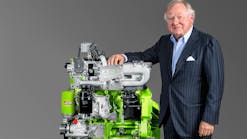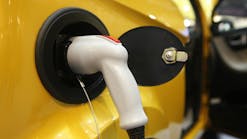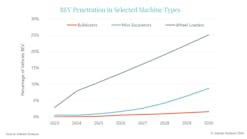As befit the theme, reporters’ questions pertained to gas and its use as a fuel for heavy trucks. They also chimed into the hype over natural gas in the general news media. Gas has been the buzz since drilling and production of it has boomed in the shale-rock areas of Pennsylvania and Ohio, and similar formations in Texas.
Conversion Links
Considering a conversion to something other than diesel?
Gas is cheap at the pump, too, and it pleases clean-air advocates who love its clean-burning characteristics in power plants and vehicle engines. That’s gained the attention of financially savvy and “green”-thinking fleet executives who have been clamoring for vehicles able to use this fair-haired fuel.
As one of those reporters at the Kenworth meeting, I asked my share of gas questions. But it occurred to me that while gas is cheap, it’s expensive to handle and store, both on and off the trucks. Government incentives offset some of the expense, but would we even be having this discussion without taxpayer-supported grants and tax credits? So I interrupted the nonstop flow of gas-related queries by asking, “Andy, what percentage of heavy trucks out there now are gas-powered? And how many will be built in the next few years?”
Douglas paused to think, then answered, “Maybe 1 percent, and in the next few years it might go to 3 or 4 percent.” Put another way, 99 percent of the trucks on the road now are diesel, and that huge majority will shrink only slightly. Diesels have improved over the years and now burn so cleanly that their pollutants can hardly be measured, he said of the engines. And “you can’t beat it for energy density,” he said of the Btu-rich but ultra low-sulfur fuel.
Modern diesels have not been without their problems, to put it politely. But Douglas said their positive attributes will continue to make diesels practical and popular, operationally and financially. Later, in a telephone conversation, so did Allen Schaeffer, who heads the Diesel Technology Forum, an advocacy group based near Washington.
“Diesel will dominate for all the reasons that it has dominated in the past,” he said, “and for new reasons: energy density, power, legendary reliability and longevity. And now it’s meeting the most stringent exhaust emissions standards in the world. Soon it will be meeting greenhouse gas emissions limits, using proven technologies.”
What they burn might change somewhat, he said. Blends of petroleum diesel with biofuels—biodiesel—will probably become more popular, while more “drop-in” alternative fuels are being developed. Dimethyl ether (DME) is among the fuels coming from renewable biomass and gas-to-liquid technologies. “There’s no question that diesel compression-ignition technology will be around for a long time,” Schaeffer said. “The question is, what is the fuel that will go in them?”
One of the goals of domestically made alternative fuels is weaning America off imported oil, especially that from the unstable Middle East, where many people hate us. Yet the majority of our oil imports come from our friendly neighbor, Canada. Meanwhile, an oil boom is in progress in the Bakkan region of North Dakota. Some experts say we could be self-sufficient in oil and other energy in another 20 or so years, so diesel will still be available everywhere, even if its price remains high.
Truck builders stay with diesels
The advantages and overwhelming popularity of the diesel are why Paccar, which owns Kenworth and Peterbilt and develops products for both, is not working on gas engines, and instead relies on Cummins Westport to supply them. That’s exactly the strategy of Daimler Trucks North America, whose Detroit arm makes only diesels for Freightliner and Western Star.
Largely for lack of money, Navistar International has shelved its work on a dual-fuel gas-diesel engine and decided, like the others, to buy them from Cummins Westport (not to mention some engines and aftertreatment equipment from Cummins). All see promise for natural gas, but not nearly enough volume to invest money in it.
Only Volvo Trucks continues a commitment to a dual-fuel gas-diesel engine, due out next year, as well as one that will use DME, scheduled for 2015. Both are based on Volvo’s 13-liter diesel. Meanwhile, Volvo and Mack, its sister company, offer Cummins Westport gas engines, but sell far more of their own diesels.
‘Costs of gas’
“As an industry, we’ve been evangelizing about gas and its benefits, and that’s fine,” Kenworth’s Douglas opined at the Chillicothe event. “But what are the total costs of gas? What are the running costs,” including erecting or providing access to fueling stations, and maintaining the trucks?
Kenworth reps talk about the costs with customers interested in compressed or liquefied natural gas because of its clean-burning characteristics and its low and stable cost as a fuel, he said. Some fleets buy gas for as low as $1.20 per diesel-gallon-equivalent, including a 50-cent-per-gallon federal tax credit. That incentive expires at the end of this year, but a bill in Congress would extend it, for gas and certain other fuels.
Yet the premium for a gas-powered heavy truck is $30,000 to $60,000, and a fueling station is expensive: into the hundreds of thousands of dollars for CNG and millions for LNG. Government support has been available to pay some of those costs and make gas financially feasible for fleets, though some managers whose trucks run sufficiently high miles say the cheap fuel can pay off a high investment within a few years, even without incentives.
Many construction fleets fit the description of the gas-truck operators that Douglas sees: They run locally, returning home nightly so they can refuel. For instance, Ozinga Ready Mix in Chicago is successfully using CNG, as is Ferrara Bros. in New York City. But they are exceptions. Fleet managers in this business are conservative in their outlook, preferring to continue using what works, and for them it’s diesel.
Fleet execs’ views
Mike Bates, CEM, equipment manager at Cajun Constructors in Baton Rouge, La., says he’s not against the idea of alternative fuels or diesel-electric hybrids, but he’s not seen products that are readily available or would work in his company’s operations.
“A convenient opportunity for alternative fuels, propane or natural gas, has not presented itself,” he said. “It’s not available to us. It’s just not out there in the areas that we work, that I’m aware of. We have our own diesel station at our maintenance facility, but not in the field for the construction equipment. To fuel them we have bulk tanks delivered, and have smaller tanks in pickups.”
Yet Cajun has tried hybrid construction equipment with success, he said. “We have demonstrated diesel-electric hybrid machines. They were pretty impressive, and used substantially less fuel than a standard type machine and productivity that’s comparable—a little bit less, but acceptable. I have seen a propane-diesel dual-fuel setup in a Peterbilt. And we visited the F-150 plant where Ford brought up the dual-fuel (compressed natural gas-and-gasoline) system” available on SuperDuty pickups.
“But we’re so spread out; we’re a multistate contractor, so all our equipment and vehicles do not funnel through our maintenance shop at all times,” Bates said. “Therein lies the problem [with alternative fuels]. Now if you had a big site like a quarry or a mining operation, then you could do it, have your filling station set up. Now if I’m hauling a crane across four states, and it takes three or four trucks to do it, how am I gonna capture the fuel, and if it breaks down, who’s gonna work on it?
“I’m not opposed to it, and I’m all in favor of reducing expenses in the way of fuel savings and in extending the life of equipment. It’s just that infrastructure is not there, and the support is not there, as far as I know. “
Ernst Ready Mix, headquartered in Dayton, Ohio, has about 250 rear-engine, front-discharge concrete mixer trucks that run in Ohio, Indiana, Kentucky and Georgia. Most are from Terex Advance. They’re all diesel-powered, and future trucks likely will be as well, said the vice president of operations, Mark Vandegrift. He noted that “Go Green, See Green,” is the company’s slogan as well as the color on its trucks, and that’s why Ernst has resumed buying new trucks after the Great Recession instead of less costly glider-kitted ones.
“We have more upfront cost with new, but on the back end we have more resale, too,” he said. “We’re putting in all the Tier IV engines, [which generally correspond to Environmental Protection Agency’s 2010 on-highway standards for diesel emissions]. We’re just trying to be more environmentally friendly and stay in tune with the EPA. With gliders, you’re just putting the old engines back in the environment. There are a lot of unknowns with the new engines, but it’s what the future will be.”
Natural gas probably wouldn’t work for Ernst, because many of its concrete plants and operating locations are in rural areas that aren’t close to gas transmission mains. Thus gas couldn’t be piped to fueling stations, and it’s not practical to haul it to where Ernst would need it.
Barth Burgett, CEM, senior vice president for equipment and part owner of Kokosing Construction, headquartered in Westerville, Ohio, said diesel still looks good.
“Are we going to stay with diesel versus propane or electric or some other stuff? I’d say yes, but we have looked at other things,” Burgett said. “We looked at the Chevy hybrid [pickup], but felt it was too light for us. We looked at biodiesel, but it has its problems—[lack of] consistency and [gelling in] cold weather. We looked at the hybrid medium-duty truck, like utilities and municipal fleets are using—fleets that do a lot of braking [while driving], but we don’t do that.”
What about propane?
That two executives brought up propane—also known as liquefied petroleum gas, or LPG—as an alternative fuel would please its advocates, who feel the facts about this clean, cheap and readily available fuel have been obliterated by the hype over natural gas. No diesel has been modified with spark ignition to burn 100 percent propane, but could be, sources acknowledge.
But both fuels can be added to the air flow of a diesel and mixed with it in combustion chambers. This is a type of dual-fuel operation called fumigation, and many independent suppliers have kits that can be added to existing diesels to capture some of the economies of these fuels. But even after looking at these you will probably stay with diesel. Knowing this, Kenworth people displayed three additional trucks and tractors at their event in July, and they had diesels.





